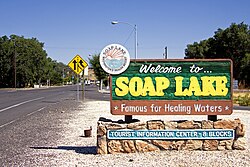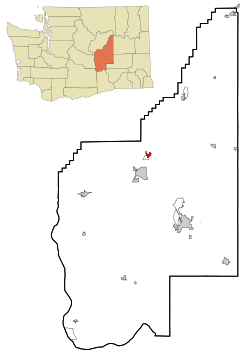Soap Lake, Washington
| Soap Lake | |
|---|---|
| City | |
| Soap Lake, Washington | |

Welcome sign in Soap Lake
|
|
 Location of Soap Lake, Washington |
|
| Coordinates: 47°23′18″N 119°29′15″W / 47.38833°N 119.48750°WCoordinates: 47°23′18″N 119°29′15″W / 47.38833°N 119.48750°W | |
| Country | United States |
| State | Washington |
| County | Grant |
| Area | |
| • Total | 1.25 sq mi (3.24 km2) |
| • Land | 1.25 sq mi (3.24 km2) |
| • Water | 0 sq mi (0 km2) |
| Elevation | 1,106 ft (337 m) |
| Population (2010) | |
| • Total | 1,514 |
| • Estimate (2015) | 1,580 |
| • Density | 1,211.2/sq mi (467.6/km2) |
| Time zone | Pacific (PST) (UTC-8) |
| • Summer (DST) | PDT (UTC-7) |
| ZIP code | 98851 |
| Area code(s) | 509 |
| FIPS code | 53-65345 |
| GNIS feature ID | 1512667 |
| Website | City of Soap Lake |
Soap Lake is a city in Grant County, Washington, on the shores of Soap Lake. The population was 1,514 at the 2010 census. In 2002, the city announced preliminary plans to construct the world's largest lava lamp (60 feet in height) as a tourist attraction.
Soap Lake was officially incorporated on June 9, 1919.
The choosing of the town’s name ended the battle between two rival factions. One group had platted a town site and called it Siloam in 1905; while another faction named their town-to-be Cottage City on 1908. The name Soap Lake came from the word Smokiam, an Indian term which translates to “Healing Waters.” The tribes used the lake for healing purposes for themselves and their animals for many years before the area was settled by pioneers.
At that time, Soap Lake was already a busy resort and health spa. It contained four hotels and many rooming houses and businesses catering to sojourners seeking a cure. The residents were very proud of the two-room schoolhouse built in 1907. Even though Soap Lake’s main industry was derived from the medicinal lake, it became a social center. In its heyday celebrations, socials, and gatherings where held continuously. Especially well known were the open-air dances, which would draw participants from miles around.
This came to a halt during the Depression; drought hit Soap Lake. Because of the lack of water and the lack of money, the tourist trade dwindled. But, when Grand Coulee Dam was built, the irrigation canals brought new life into the area. Soap Lake has been internationally known during the past century for its uniquely mineral-rich (23) waters and mud. Many people believe the water and mud to be successful in treatment of a variety of aliments. From the early 1900s to the mid-1940s there were a number of sanitariums located on Soap Lake.
These early versions of spas were used by visitors from all over the country and the world. When the sanitariums, hotels, and bath houses were full, people slept in tents, and even under their cars, in order to use the water of the lake. In 1933, the Veteran’s Administration sent nine veterans, under a special project, to Soap Lake for treatment of Buerger's disease. In November 1938, McKay Hospital was completed. For a number of years, McKay was used as a research center for the study of the therapeutic effect of the water of the lake and the climate.
...
Wikipedia
